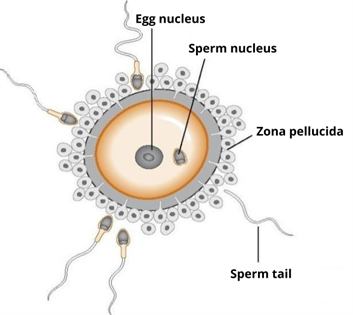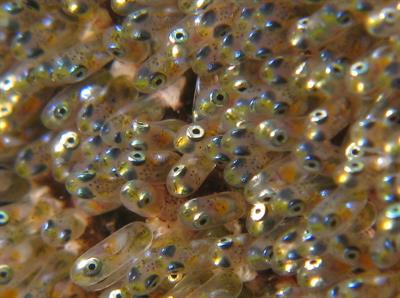
PUMPA - SMART LEARNING
எங்கள் ஆசிரியர்களுடன் 1-ஆன்-1 ஆலோசனை நேரத்தைப் பெறுங்கள். டாப்பர் ஆவதற்கு நாங்கள் பயிற்சி அளிப்போம்
Book Free Demo In sexual reproduction, there is the involvement of two gametes, the male and the female gamete. When the sperm comes in contact with the egg, only one sperm (sometimes two) is allowed to fuse with the ovum.
The fusion of the male gamete (sperm) with the female gamete (ovum or egg) gives rise to a new cell called the zygote during sexual reproduction is called fertilisation.
During fertilisation, nuclei of the sperm from the father and the egg of the mother fuse to form a single nucleus, and the formation of a fertilized egg or the zygote.

The sperm and ovum during the fertilization
Thus the new individual inherits both the characteristics of mother and father.
Important!
All multicellular animals start life from this single cell zygote but contains two nucleus.

Structure of zygote
Fertilisation can take place either inside the female body or outside the body of the female. The two modes of fertilisation are:
- Internal fertilisation
- External fertilisation
Internal fertilisation:
When the fusion of male and female gamete (fertilisation) takes place inside the body of a female animal, it is called as internal fertilisation.
The females eggs or ovum are fertilized by the sperm of the male inside the body.
Example:
Tigers, cats, dogs, hen, reptiles like snakes, crocodiles, cows, and human.
External fertilisation:
When the fusion of male and female gamete (fertilisation) takes place outside the body of a female animal, it is called as external fertilisation.
The females eggs or ovum are fertilized by the sperm of the male outside the body.
- In fishes, frogs, salmon, jellyfish, and sea urchin the fertilisation of the egg happens outside in a pond or a lake.
- When the male and female frog come together, the female release hundreds of eggs (delicate with jelly layer, not covered by shell).
Example:

Fish eggs
The male release millions of their sperm in the water. Sperms swims in water to reach the eggs, and fertilisation occurs due to collision between the sperm and eggs.
Not all eggs are fertilised into the zygote. This is because:
- Many eggs are carried away through the movement of water, wind, and rainfall.
- Animals present in the pond may feed on the eggs.
- Even the larvae that are hatched after fertilisation may die as the other organisms may feed upon them.
Thus, the production of hundreds of eggs is necessary to yield a few offspring in external fertilisation.
Reference:
https://upload.wikimedia.org/wikipedia/commons/5/5f/The_sperm_and_ovum_during_fertilization.svg
https://upload.wikimedia.org/wikipedia/commons/e/ee/Zygote.jpg
https://www.flickr.com/photos/silkebaron/3897962738